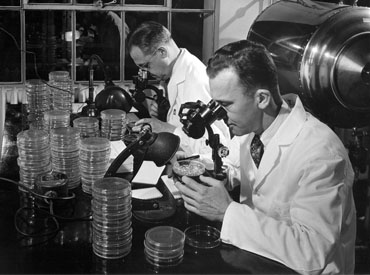Dentistry Research During the Depression Lays Foundation for NIH's NIDCR
“And he said, ‘I can assure you that if you go through and become a good dentist, people will travel all over the world to find you. Chemists travel all over the world to find a job.”
That was the advice for Dr. Francis Arnold, who did become a dentist and helped establish the National Institute of Dental and Craniofacial Research, from his mentor, Dr. Thomas Hill, Professor of Clinical Oral Pathology and Therapeutics at Western Reserve University. The excerpt, and those below, come from Dr. Arnold's 1964 NIH oral history series, the first of which is here. During the interviews, he discusses how his experiments and interests led him to become one of the four Public Health Service scientists who pioneered the study of fluorides and their effect on teeth.

Francis Arnold (right) and Philip Jay in the lab
From the archive:
“People, particularly a group out in Iowa, were proposing the application of silver nitrate on deciduous teeth, particularly anterior teeth, to stop decay, which is quite interesting, I think. Dr. Hill happened to be the type of person that believed that a young person [starting] research, such as myself, for his first project should do something that he can get a result, yes or no. So together we worked out a relatively simply experience, which was namely: By treating a tooth with silver nitrate, do you make it less soluble to acid? Which became just a straight chemical experiment in terms of treating teeth and then analyzing the rapidity of their solubility in different buffered acid solutions. So that was the background of the first research experiment I ran and reported on, and was the basis of the first report I ever made. This was made at the meeting of the International Association of Dental Research. I'm not positive whether it was 1935 or ’36.
"It wasn't that profound an experiment, as I see it today. It was an interesting one. In fact, I think one of the interesting facts in that, and I still remember it, was that as I went into this experiment and began to get some results, [and] then taking my results, as I thought I had completed an experiment, I had completed one phase of a minor experiment is really what had happened, and we reported. I think Hill wanted me to report it at the IADR meeting simply to give me the experience of standing up and defending my experiment. But anyhow, we did that.
"As I finished it and then took it to more experienced people and to Hill himself, they then started asking me the questions of why had I gotten the result. Up to then, I had just gotten a result and I had not really considered why. It was during the discussions and also of going through the literature and studying the problem a little bit more, that I became interested. Actually, I was wondering whether chlorination of a water supply would increase dental decay, dental caries. Then my reasoning behind this was that after we went in and I took my results to the biochemists, then they wanted me to go back and start why. Then I had to find out what had the silver nitrate done and why had it changed the solubility, because it did decrease solubility. And was it the silver ion? And what was coming off? This was just by weight measurement, dissolving a weighed sample of enamel and of dentine, and then weight differential during a time period versus a concentration of acid. But then they posed the problem which naturally comes up then: 'What did change and how was it changed?' We got to discussing it, and, of course, it was easy to show that certain of the components of enamel went off more rapidly than others, and also that chloride entered into this picture, that is, the chloride ion.
"So I began to wonder, and I can remember many discussions along this line with Tom Hill and all, of whether chlorination of the water supply increased dental decay, basing it on the rationale that we knew from the experience that as civilization had gone along and, shall we say, advanced, dental decay has advanced. One of the factors over the past many years of advance has been chlorination of the water, purification of water supplies. I was wondering whether this might relate. We also fooled around with the potentiality of fluoride as being one of the elements that would decrease enamel and dentine solubility. But really, my thought was to try to follow through from an epidemiological standpoint on the chlorine, chlorination, and so forth of the water supply.
"Well, it was about that time that Tom Hill saw that I was interested in research, and I knew I was interested enough in research to go on. I was already in the Public Health Service, had been commissioned in the Public Health Service. I was commissioned in 1936. We got in touch, and Hill suggested that I try to get assigned with Trendley Dean here at NIH. Trendley, at the time, was working on water supplies, and this was prior to [the] dental caries picture of fluoride, but had been working on water supplies and the relationship of fluoride and fluoride waters to mottled enamel. Hill knew Trendley Dean quite well, and he knew Messner, who was the chief dental officer at the time. So that gives the background of how I got assigned, finally, to NIH.”
Read more about the events of the time in Dr. Arnold's five-part NIH oral history, found at http://history.nih.gov/archives/oral_histories.html.
Related Blog Posts
This page was last updated on Wednesday, July 5, 2023
